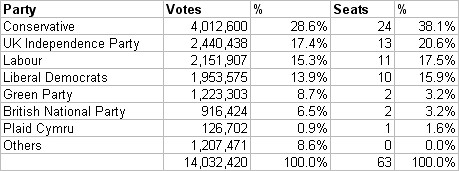I've been crunching some numbers on the UK's European Parliament election results. And despite the system they use supposedly being "proportional", they show significant disproportionalities. Here's the results sans Scotland, which won't be out till tomorrow:

The reason for this unfairness is because for these elections the UK chops itself into 12 districts (9 regions plus Scotland, Wales and Northern Ireland) of between 3 and 10 seats, and applies the D'Hondt method within each one. This effectively introduces a large threshold (upwards of 10%) within each region, and allocates the "rounding error" to the larger parties 9as D'Hondt favours them). Which adds up on a national scale to the sorts of disproportionality seen above.
The EU's rules for how member states run elections are pretty simple, and require only three things:
- The system must be a form of proportional representation, under either the party list or Single Transferable Vote system.
- The electoral area may be subdivided if this will not generally affect the proportional nature of the voting system.
- Any election threshold on the national level must not exceed five percent.